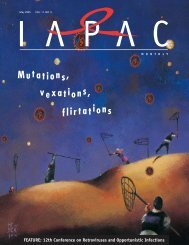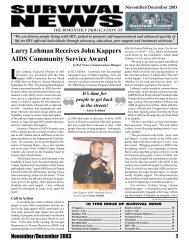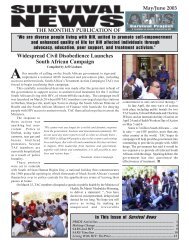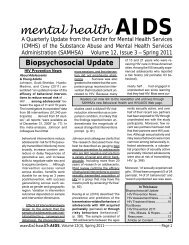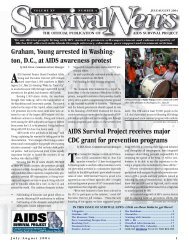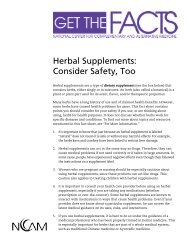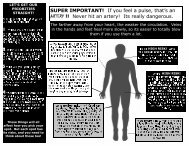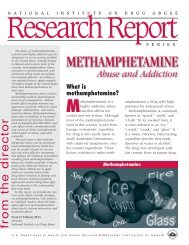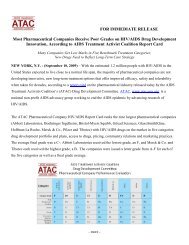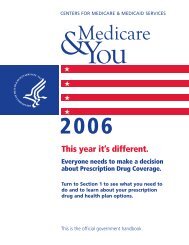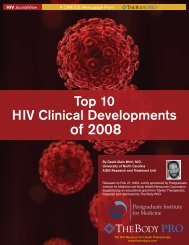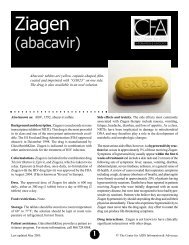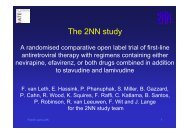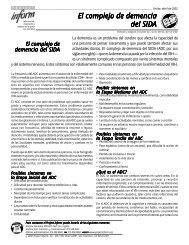here - CD8 T cells - The Body
here - CD8 T cells - The Body
here - CD8 T cells - The Body
You also want an ePaper? Increase the reach of your titles
YUMPU automatically turns print PDFs into web optimized ePapers that Google loves.
and the multiple molecular<br />
mechanisms which maintain<br />
HIV latency. HIV is not completely<br />
eradicated from the<br />
body by standard antiretroviral<br />
therapy because some of it<br />
lies resting in memory CD4+T<strong>cells</strong>,<br />
which can proliferate for<br />
an average of 73.4 years in<br />
the human body. However, if<br />
you stop taking therapy, the<br />
virus typically comes roaring<br />
back within a matter of weeks.<br />
One eradication approach<br />
would be to remain on standard<br />
ARV therapy to keep<br />
the virus suppressed, while at<br />
the same time purging these<br />
latent reservoirs and blocking<br />
them from infecting new<br />
<strong>cells</strong>, so that they would have<br />
now<strong>here</strong> to go and eventually<br />
die off, ridding the body of<br />
HIV. But it’s complicated—the<br />
number of latently infected<br />
<strong>cells</strong> may be much higher<br />
than previously thought, by as<br />
much as 50-fold, according to<br />
Siliciano.<br />
Sarah Palmer, PhD, Swedish<br />
Institute for Communicable<br />
Disease Control and Karolinska<br />
Institute, gave a presentation<br />
on measuring persistent HIV<br />
infection, including an excellent<br />
slide outlining some of the<br />
advantages and disadvantages<br />
of the four currently available<br />
assays which measure persistence.<br />
In concluding her talk,<br />
Palmer emphasized that “looking<br />
ahead, to determine the<br />
effectiveness of curative strategies,<br />
our field will need to<br />
develop a more standardized<br />
assay system which is sensitive,<br />
efficient, less costly, and<br />
adaptable in local settings.”<br />
Other presentations<br />
covered recent advances in<br />
the development of accurate<br />
animal models for<br />
use in future cure<br />
research, vaccine<br />
and immune-based<br />
therapies and the role<br />
of immune activation<br />
and inflammation in<br />
viral persistence.<br />
<strong>The</strong> conference<br />
ended with a slightly<br />
unorthodox, yet<br />
immensely informative<br />
and entertaining<br />
presentation by Fred<br />
Verdult of Amsterdam<br />
on the psychosocial<br />
benefits of a cure for<br />
HIV. Verdult, after<br />
finding out he had HIV<br />
in 1998, started Volle<br />
Maan, an organization<br />
that conducts studies<br />
and communication projects<br />
on health and disease to<br />
encourage people to live full<br />
and worthwhile lives. Volle<br />
conducted a survey of 458<br />
individuals in the Netherlands<br />
asking how important to them<br />
a cure for HIV is, why a cure is<br />
important, and which type of<br />
cure is preferred.<br />
<strong>The</strong> majority of the survey<br />
respondents indicated they<br />
were in good health, with<br />
only 14% stating that their<br />
health was poor. Seventy-two<br />
percent said that it was very<br />
important to them to be cured<br />
of HIV, while another 22% said<br />
it was somewhat important.<br />
Yet when asked about how a<br />
cure might look, participants<br />
had varying responses. 95%<br />
thought that a total cure<br />
without any risk of future<br />
transmission or infection very<br />
desirable, while only 41% considered<br />
it desirable to have a<br />
cure that had no risk of future<br />
transmission but carried a risk<br />
ShARP TuRn: PA contributor Matt<br />
Sharp talks about his experiences as a<br />
cure research study participant.<br />
of future infection. <strong>The</strong> survey<br />
also asked about disadvantages<br />
of living with HIV—the<br />
risk of experiencing health<br />
problems in the future was<br />
the number one answer, while<br />
psychosocial effects such as<br />
stigma and the risk of infecting<br />
someone else were also<br />
highly ranked.<br />
Deeks closed the twoday<br />
workshop by declaring<br />
Verdult’s presentation the<br />
“highlight of the meeting,”<br />
and remarking on the spirit<br />
of collaboration among the<br />
attendees. Barré-Sinoussi said<br />
that next steps include the<br />
efforts of the working groups,<br />
including a newly added<br />
social sciences research team<br />
and an ethics working group,<br />
as well as a call for more cure<br />
research funding and collaboration.<br />
<strong>The</strong> next IAS Towards<br />
an HIV Cure workshop is<br />
scheduled for immediately<br />
prior to the 2013 international<br />
conference in Kuala Lumpur,<br />
Malaysia.<br />
Other news on<br />
the cure front<br />
A group of patients in France<br />
who became infected with<br />
HIV and then started on<br />
antiretroviral therapy (ART)<br />
early in the post-infection<br />
period have shown no signs<br />
of a resurgence of their Hiv<br />
infection seven years after<br />
being taken off therapy.<br />
“<strong>The</strong>se results suggest<br />
that…antiretroviral treatment<br />
should be started very early<br />
after infection,” said Charline<br />
Bacchus, lead researcher<br />
of the study at the French<br />
National Agency for Research<br />
on AIDS and Viral Hepatitis<br />
(ANRS).<br />
<strong>The</strong> patients in the ANRS<br />
EP47 VISCONTI cohort (known<br />
as the Visconti Cohort) have<br />
an extremely low reservoir of<br />
HIV in their <strong>cells</strong> similar to that<br />
of “HIV controller” patients.<br />
HIV controllers are those who<br />
are able to control their HIV<br />
infection without the use of<br />
ART for an extended period of<br />
time, and represent about one<br />
out of every 300 people who<br />
have HIV.<br />
In the study, 12 patients<br />
started therapy within 10<br />
weeks of infection, were on<br />
therapy for an average of<br />
three years, and were able to<br />
control HIV after an average<br />
of seven years off therapy.<br />
At a press conference Asier<br />
Saez-Cirión, one of the study<br />
investigators, said they<br />
were interested in finding<br />
out whether HIV controller<br />
status could be induced. He<br />
estimated that 5–15% of those<br />
treated early could eventually<br />
control HIV off therapy. But<br />
don’t stop those HIV meds<br />
POSiTivElyAwARE.COM SEPTEMBER+OCTOBER 2012 35



